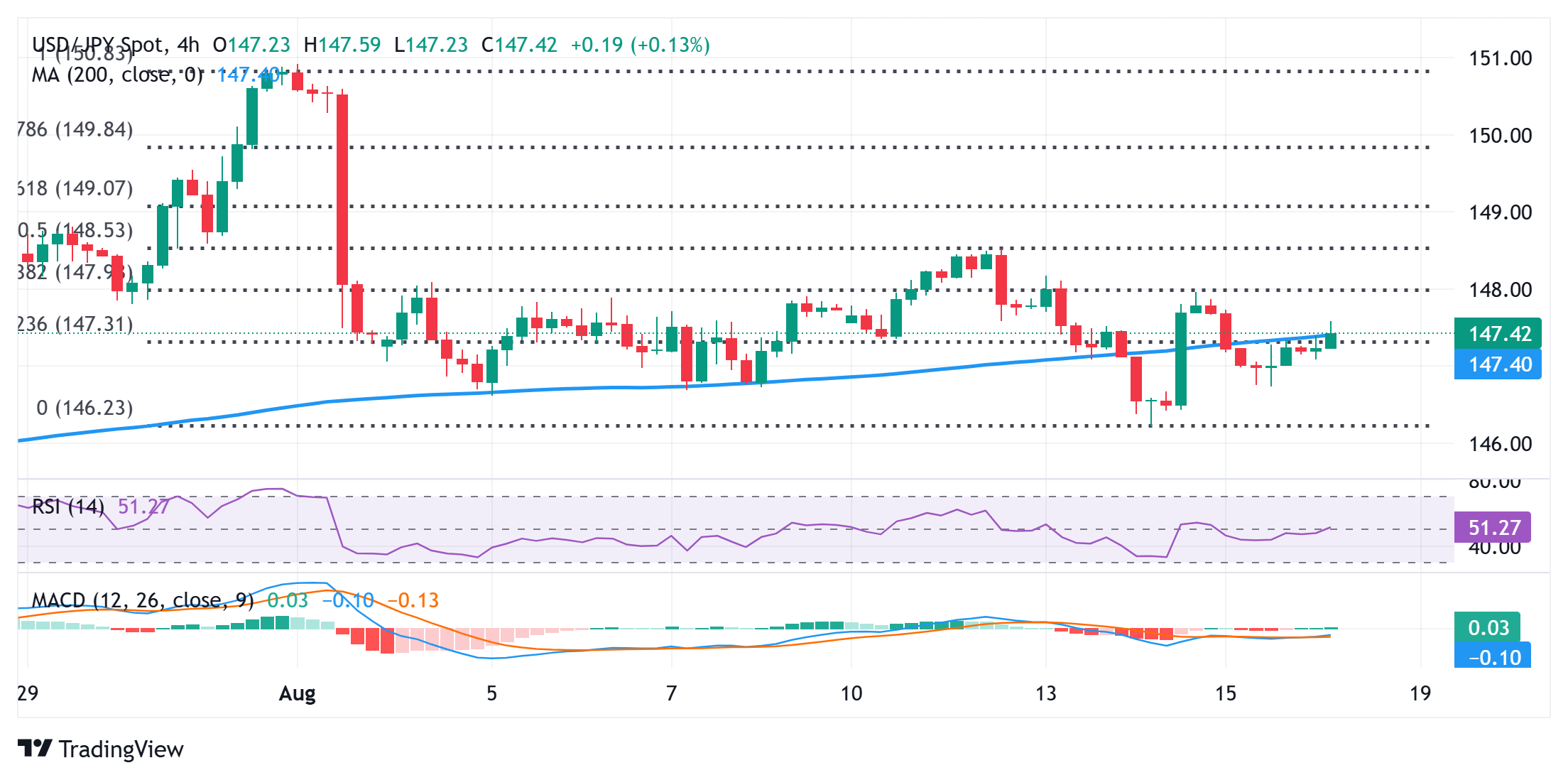Created
: 2025.08.18














![]() 2025.08.18 12:38
2025.08.18 12:38
The Japanese Yen (JPY) kicks off the new week on a weaker note amid a combination of factors, which, along with a modest US Dollar (USD) uptick, lifts the USD/JPY pair to mid-147.00s during the Asian session. The uncertainty over the likely timing of the next interest rate hike by the Bank of Japan (BoJ), along with the prevalent risk-on environment, is seen undermining the safe-haven JPY. However, firming expectations that the BoJ will stick to its policy normalization path might hold back the JPY bears from placing aggressive bets.
Meanwhile, a relatively hawkish BoJ marks a significant divergence in comparison to other major central banks, including the Federal Reserve (Fed), which is anticipated to resume its rate-cutting cycle in September. This could act as a headwind for the USD and benefit the lower-yielding JPY, warranting some caution before positioning for any further appreciating move for the USD/JPY pair. Traders might also opt to move to the sidelines ahead of Fed Chair Jerome Powell's speech at the Jackson Hole Symposium later this week.

The USD/JPY pair has been oscillating in a familiar range over the past two weeks or so. This points to a consolidation phase and makes it prudent to wait for an eventual break on either side before positioning for the next leg of a directional move amid neutral technical indicators on the daily chart.
Meanwhile, an intraday rise beyond the 23.6% Fibonacci retracement level of the downfall from the monthly swing high backs the case for additional gains. Any further move up beyond the 200-period Simple Moving Average (SMA) on the 4-hour chart, however, is likely to confront stiff resistance near the 148.00 mark, or the 38.2% Fibo. retracement level.
A sustained strength and acceptance above the said handle might shift the near-term bias in favor of bulls. The USD/JPY pair might then climb to the 148.55-148.60 region, or the 50% retracement level, and extend the positive momentum further towards the 149.00 round figure.
On the flip side, the 147.10-147.00 area could offer immediate support, below which the USD/JPY pair could retest the multi-week low, around the 146.20 zone, touched last Thursday, Some follow-through selling, leading to a subsequent fall below the 146.00 round figure, will be seen as a fresh trigger for bearish traders and make spot prices vulnerable to extend the fall to the the 145.40-145.30 region en route to the 145.00 psychological mark.
The Japanese Yen (JPY) is one of the world's most traded currencies. Its value is broadly determined by the performance of the Japanese economy, but more specifically by the Bank of Japan's policy, the differential between Japanese and US bond yields, or risk sentiment among traders, among other factors.
One of the Bank of Japan's mandates is currency control, so its moves are key for the Yen. The BoJ has directly intervened in currency markets sometimes, generally to lower the value of the Yen, although it refrains from doing it often due to political concerns of its main trading partners. The BoJ ultra-loose monetary policy between 2013 and 2024 caused the Yen to depreciate against its main currency peers due to an increasing policy divergence between the Bank of Japan and other main central banks. More recently, the gradually unwinding of this ultra-loose policy has given some support to the Yen.
Over the last decade, the BoJ's stance of sticking to ultra-loose monetary policy has led to a widening policy divergence with other central banks, particularly with the US Federal Reserve. This supported a widening of the differential between the 10-year US and Japanese bonds, which favored the US Dollar against the Japanese Yen. The BoJ decision in 2024 to gradually abandon the ultra-loose policy, coupled with interest-rate cuts in other major central banks, is narrowing this differential.
The Japanese Yen is often seen as a safe-haven investment. This means that in times of market stress, investors are more likely to put their money in the Japanese currency due to its supposed reliability and stability. Turbulent times are likely to strengthen the Yen's value against other currencies seen as more risky to invest in.
![]()
Created
: 2025.08.18
![]()
Last updated
: 2025.08.18

FXStreet is a forex information website, delivering market analysis and news articles 24/7.
It features a number of articles contributed by well-known analysts, in addition to the ones by its editorial team.
Founded in 2000 by Francesc Riverola, a Spanish economist, it has grown to become a world-renowned information website.
We hope you find this article useful. Any comments or suggestions will be greatly appreciated.
We are also looking for writers with extensive experience in forex and crypto to join us.
please contact us at [email protected].
Disclaimer:
All information and content provided on this website is provided for informational purposes only and is not intended to solicit any investment. Although all efforts are made in order to ensure that the information is correct, no guarantee is provided for the accuracy of any content on this website. Any decision made shall be the responsibility of the investor and Myforex does not take any responsibility whatsoever regarding the use of any information provided herein.
The content provided on this website belongs to Myforex and, where stated, the relevant licensors. All rights are reserved by Myforex and the relevant licensors, and no content of this website, whether in full or in part, shall be copied or displayed elsewhere without the explicit written permission of the relevant copyright holder. If you wish to use any part of the content provided on this website, please ensure that you contact Myforex.
Myforex uses cookies to improve the convenience and functionality of this website. This website may include cookies not only by us but also by third parties (advertisers, log analysts, etc.) for the purpose of tracking the activities of users. Cookie policy